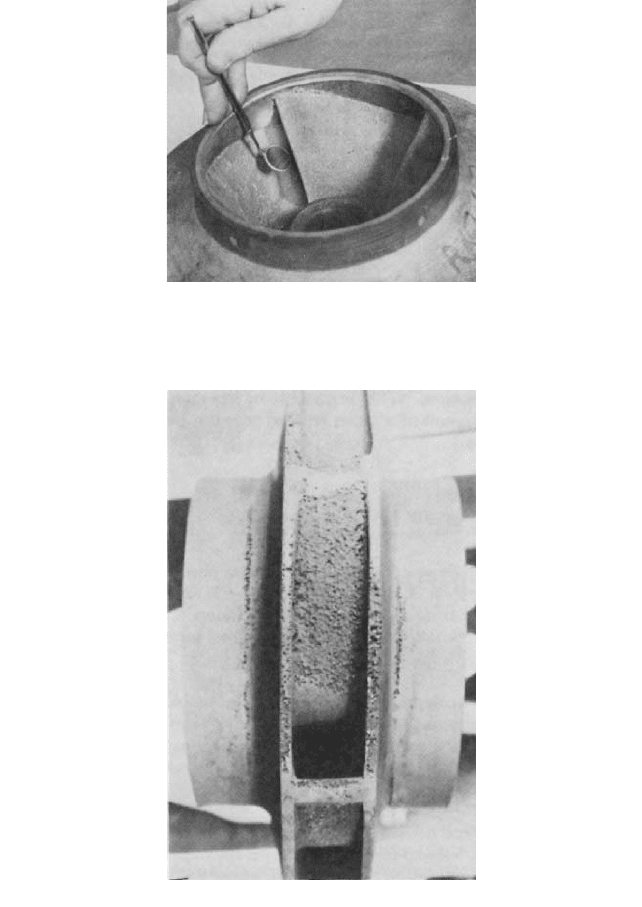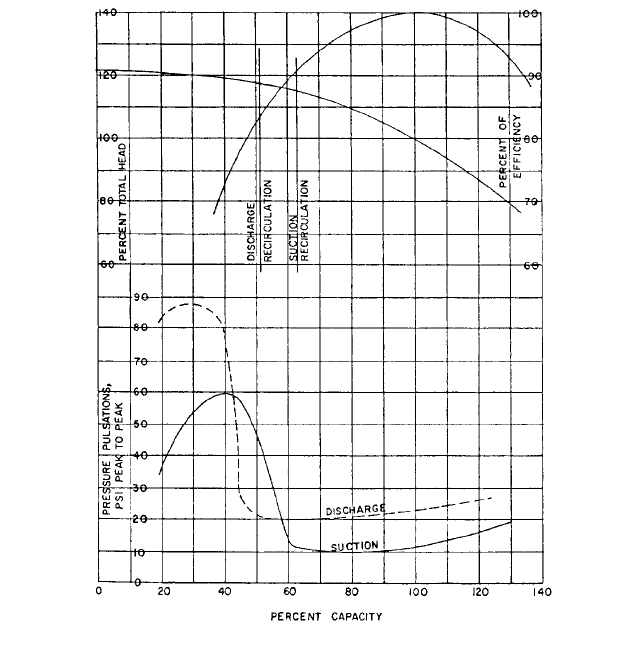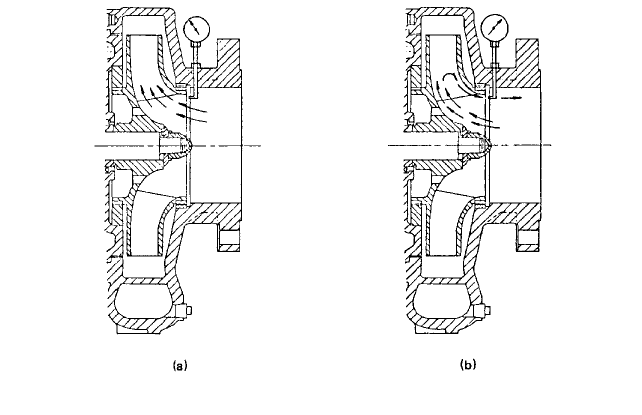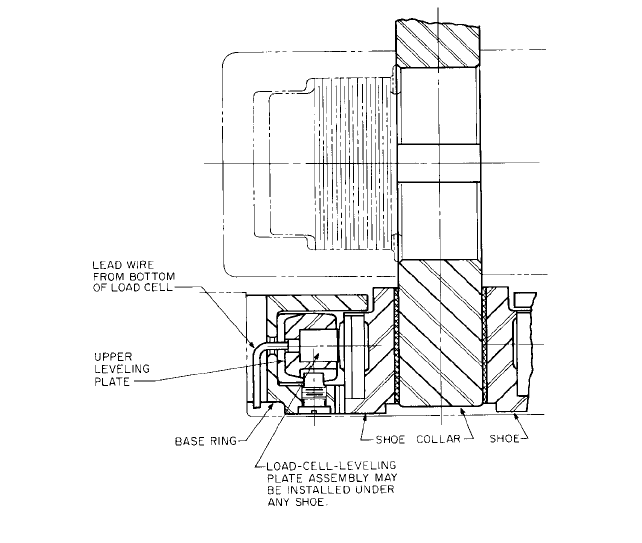Pump Handbook by Igor J. Karassik, Joseph P. Messina, Paul Cooper, Charles C. Heald - 3rd edition
Подождите немного. Документ загружается.

2.3.1 CENTRIFUGAL PUMPS: GENERAL PERFORMANCE CHARACTERISTICS 2.395
FURTHER READING __________________________________________________
Anderson, H. H. Centrifugal Pumps, Trade and Technical Press, Surrey, England, 1980.
Brennen, C. E. Hydrodynamics of Pumps, Concepts ETI, Inc., and Oxford University
Press, 1994.
Carter, R.“How Much Torque Is Needed to Start Centrifugal Pumps?” Power 94(1):88, 1950.
Church, A. H. Centrifugal Pumps and Blowers. Krieger Publishing, Malabar, FL, 1944.
Heald, C. C. Cameron Hydraulic Data, 18th ed., 1998. Flowserve Corporation, Irving, TX
75039.
Japikse, D., Marscher, W. D., and Furst, R. B. Centrifugal Pump Design and Performance.
Concepts ETI, Inc., Wilder, VT, 1997.
Moody, L. F., and Zowaki, T. “Hydraulic Machinery.” 3rd ed., sec. 26 of Handbook of Applied
Hydraulics. Davis and Sorenson, eds., McGraw-Hill, New York, 1969.
Spanohake,W. Centrifugal Pumps,Turbines, and Propellers. Technology Press, MIT, Cam-
bridge, MA, 1934.
Wislicenus, C. F. Fluid Mechanics of Turbomachinery. Dover, New York, 1965.
2.3.2
CENTRIFUGAL PUMP
HYDRAULIC PERFORMANCE
AND DIAGNOSTICS
WARREN H. FRASER
2.397
Any successful mathematical model of the mechanics of head generation in centrifugal
pumps should do more than just make accurate predictions of pump performance; it
should also be capable of identifying the cause of operational difficulties. Unlike mechan-
ical malfunctions, which can be detected, analyzed, and corrected, many of the problems
caused by hydraulic forces cannot be corrected in the mechanical sense
—
they are the
unavoidable side effects of head generation in a rotating pressure field. For example, a
thrust bearing may fail from lack of lubrication, from misalignment, or because an under-
rated bearing has been used. These are mechanical failures that can be corrected. A thrust
bearing may also fail from a complex pattern of dynamic loading that reflects pressure
pulsations of high intensity and a broad spectrum of frequencies during operation at
reduced flow. This is an example of a failure from hydraulic causes and can be corrected
only by resorting to an oversized bearing or modifying the operation of the pumping sys-
tem to avoid low-flow operation.
Whenever a consistent correlation can be made between the known dynamics of head
generation and operational problems, it is possible to devise a strategy to improve opera-
tion and reduce mechanical failures. The most significant problems caused by hydraulic
dynamic forces can be listed as follows.
CAVITATION _________________________________________________________
Cause and Effect
Cavitation is the formation of vapor bubbles in any flow that is sub-
jected to an ambient pressure equal to or less than the vapor pressure of the liquid being
pumped. Cavitation damage is the loss of material produced by the collapse of the vapor
bubbles against the surfaces of the impeller or casing. Formation of these bubbles cannot
occur if the net positive suction head supplied, or NPSHA, exceeds the NPSH required for
2.398 CHAPTER 2
cavitation inception. This NPSH inception value is usually significantly higher than the
usually mentioned NPSH required, or NPSHR, which is based on a certain amount of cav-
itation being present to create a prescribed deviation in pump performance.
Diagnosis from Pump Operation Pump operation in the presence of sufficient cavi-
tation activity will reduce both the total head and the output capacity. A steady crackling
noise in and around the pump suction indicates cavitation.A random crackling noise with
high-intensity knocks indicates suction recirculation but does not indicate a degradation
of performance if NPSHA is greater than NPSHR. The random crackling is the unsteady
occurrence of cavitation that generally accompanies suction recirculation, which, in turn,
is an unsteady phenomenon.
Diagnosis from the Visual Examination of Surface Damage Cavitation damage
from inadequate NPSH (that is, NPSHA 6 NPSHR) occurs on the low-pressure or the vis-
ible surface of the impeller inlet vane.
Instrumentation A suction gage or manometer in the pump suction can be used to
determine whether the NPSH available is equal to or greater than the NPSH required
from the manufacturer’s rating curve (NPSHR).
Corrective Procedures If additional NPSH cannot be supplied, the capacity of the
pump should be reduced until the required NPSH is equal to or less than the available
NPSH. If this is not possible, impeller improvement may be necessary. This may be accom-
plished on some impeller designs by reworking the geometry or impeller surface finish to
reduce losses, improve flow characteristics, or increase the flow inlet area (thus lowering
impeller inlet velocity). If this is not possible, consideration should be given to replacing
the impeller (first stage or suction impeller on multistage pumps) with one of improved
suction performance. The pump manufacturer should be consulted to determine the most
satisfactory course of action.
SUCTION AND DISCHARGE RECIRCULATION ____________________________
Cause and Effect
Recirculation occurs at reduced flows and is the reversal of a portion
of the flow back through the impeller. Recirculation at the inlet of the impeller is known
as suction recirculation. Recirculation at the outlet of the impeller is discharge recircula-
tion. Suction and discharge recirculation can be very damaging to pump operation and
should be avoided for the continuous operation of pumps of significant energy level or
pressure rise per stage.
Diagnosis from Pump Operation Suction recirculation will produce the previously
mentioned loud crackling noise in and around the suction of the pump. Recirculation noise
is of greater intensity than the noise from low-NPSH cavitation and is a random knock-
ing sound. Discharge recirculation will produce the same characteristic sound as suction
recirculation except that the highest intensity is in the discharge volute or diffuser.
Diagnosis from Visual Examination Suction and discharge recirculation produce cav-
itation damage to the pressure side of the impeller vanes. Viewed from the suction of the
impeller, the pressure side would be the invisible, or underside, of the vane. Figure 1 shows
how a mirror can be used to examine the pressure side of the inlet vane for cavitation
damage from suction recirculation. This is unlike cavitation damage from inadequate
NPSH that occurs on the low pressure surface of the inlet vanes. Damage to the pressure
side of the vane from discharge recirculation is shown in Figure 2. Guide vanes in the suc-
tion may show cavitation damage from impingement of the backflow from the impeller
eye during suction recirculation. Similarly, the casing tongue or diffuser vanes may show
cavitation damage on the impeller side from operations in discharge recirculation.

2.3.2 CENTRIFUGAL PUMP HYDRALIC PERFORMANCE AND DIAGNOSTICS 2.399
FIGURE 1 Examining the pressure side of the inlet vanes for suction recirculation damage
FIGURE 2 Damage to the pressure side of the vane from discharge recirculation
Instrumentation The presence of suction or discharge recirculation can be determined
by monitoring the pressure pulsations in the suction and in the discharge areas of the cas-
ing. Piezoelectric transducers installed as close to the impeller as possible in the suction
and in the discharge of the pump can be used to detect pressure pulsations.The data may
be analyzed with a spectrum analyzer coupled to an XY plotter to produce a record of the

2.400 CHAPTER 2
FIGURE 3 Pressure pulsations versus capacity
pressure pulsations versus the frequency for selected flows. Figure 3 shows a typical plot
of pressure pulsations versus capacity. As can be seen, a sudden increase in the magni-
tude of pressure pulsations indicates the onset of recirculation.
The onset of suction recirculation can be determined by an impact head tube (or pitot
tube) installed at the impeller eye, as shown in Figure 4. With the tube directed into the
eye, the reading in the normal pumping range is the suction head minus the velocity head
at the eye. At the point of suction recirculation, however, the flow reversal from the eye
impinges on the head tube with a rapid rise in the gage reading.
Corrective Procedures Every impeller design has specific recirculation characteristics.
These characteristics are inherent in the design and cannot be changed without modify-
ing the design. An analysis of the symptoms associated with recirculation should consider
the following as possible corrective procedures:
1. Increase the output capacity of the pump.
2. Install a bypass between the discharge and the suction of the pump.
3. Substitute an improved material for the impeller that is more resistant to cavitation
damage.
4. Modify the impeller design.

2.3.2 CENTRIFUGAL PUMP HYDRALIC PERFORMANCE AND DIAGNOSTICS 2.401
FIGURE 4A and B Installation of the impact head tube to detect suction recirculation during (a) normal flow
and (b) recirculation flow
AXIAL THRUST ______________________________________________________
Cause and Effect
Axial thrust is the thrust imposed in the direction of the shaft. It may
occur in either the inboard or the outboard direction and is usually composed of a dynamic
cyclic component superimposed on a steady-state load in either direction. The dynamic
cyclic component increases in the recirculation zone and may impose excessive stresses
in the shaft, which could ultimately result in failure from metal fatigue. The static com-
ponent may impose an excessive load in the thrust bearing, causing unacceptable bear-
ing temperatures. The majority of thrust-bearing failures are caused by fatigue failure of
the bearing components from dynamic cyclic axial loads.
Diagnosis from Pump Operation High axial loads usually produce high thrust-bear-
ing temperatures and short thrust-bearing life.
Diagnosis from Visual Examination of Damage
BEARING DAMAGE Static thrust in excess of the bearing rating will cause cracking of the
balls or rollers and of the race in rolling element bearings and metal scorings of the shoes
in tilting-pad bearings. Bearing failure from dynamic loading in excess of the bearing rat-
ing will cause fatigue failures of the balls or rollers and race in rolling element bearings.
It is important to differentiate clearly between static load failure and fatigue failure.
This can be done by examination of a cross section of the failure zone under the micro-
scope. Fatigue failure from dynamic loading will show a hammering effect caused by
points of impact. Fatigue failure from excessive static loading will show metal fatigue
without the hammering effect of impact loading.
SHAFT FAILURE Shaft failure at the outboard, or unloaded, end of the shaft in multistage or
double-suction pumps may be a fatigue failure in tension resulting from the high cyclic
stresses induced in the shaft when the pump is operated in the discharge recirculation zone.
Axial cyclic stresses can be reduced by increasing the pump output or, if this is not possi-
ble, by installing a recirculation line to bypass sufficient flow to move the pump total flow
rate beyond the point where damaging discharge recirculation occurs. The pump manu-
facturer can advise the recommended minimum continuous flow for a specific pump design.

2.402 CHAPTER 2
FIGURE 5 Load cell to monitor axial load
Instrumentation Displacement-type pickups should be used to determine the axial
movement of the shaft relative to the bearing housing. The deflection of the thrust bear-
ing housing can be determined by seismic instruments. Axial loading of the tilting-shoe
type of thrust bearing can be monitored by a load cell permanently installed in the level-
ing plate. A typical installation is shown in Figure 5.
Corrective Procedures To determine the most effective procedure to correct axial
thrust problems, it is necessary to determine whether the loads are static, dynamic, or a
combination of both. If it is a static failure, the thrust can usually be reduced by restora-
tion of the internal clearances. Most shaft and bearing failures from axial thrust, how-
ever, are fatigue failures. If the failure is a fatigue failure, the loading can usually be
decreased by increasing the capacity of the pump. If this is not possible, shaft failures can
be reduced by substituting a shaft material of higher endurance limit. Rolling element
bearing failures can be addressed in large, between bearings pumps by substituting a tilt-
ing-shoe type of thrust bearing. The high cyclic axial forces are better absorbed in the oil
film of the tilting-shoe bearing than in the rolling element bearing.
RADIAL THRUST _____________________________________________________
Cause and Effect
Radial thrust is the thrust imposed on the pump rotor and directed
toward the center of rotation of the shaft. The forces are usually composed of a dynamic
cyclic component superimposed on a steady-state load. The dynamic cyclic component
increases rapidly at low-flow operation when the pump is operating in the recirculation
zone. The static load also increases with low- and high-flow operation, with the minimum
value at or near the maximum efficiency capacity.
2.3.2 CENTRIFUGAL PUMP HYDRALIC PERFORMANCE AND DIAGNOSTICS 2.403
Diagnosis from Pump Operation High radial thrust is difficult to determine from
pump operation. Persistent packing or mechanical seal problems may indicate excessive
shaft deflection from radial loads.As in the case of high axial loads, high radial loads may
produce high bearing temperatures with reduced life.
Diagnosis from Visual Examination of Damage
BEARING DAMAGE Static radial loads in excess of the bearing rating will cause cracking of
the balls or rollers and the races in rolling element bearings. In the case of sleeve bear-
ings, the bearing metal will be worn in one direction only and the journal will be worn
uniformly. If the opposite is true (that is, the bearing is worn uniformly and the journal
excessively in one direction), the cause of the failure is most likely unbalance or a bent
shaft and not excessive bearing loads.
SHAFT FAILURES Shaft failures from excessive radial loads usually occur at the midpoint
of the shaft span in double-suction or multistage pumps. In the case of end-suction pumps,
shaft failures usually occur at the shoulder of the shaft, where the impeller hub joins the
shaft sleeve, or at the location of the highest stress concentration, if elsewhere.
Instrumentation It is difficult to devise instrumentation to determine excessive radial
loading of the shaft and bearings. Temperature rise of the bearings may or may not be
symptomatic of excessive radial loading. High bearing temperatures may occur from mis-
alignment, inadequate lubrication, or excessive axial loading of the thrust bearing. These
causes should be eliminated before concluding that the radial loads are excessive.
Corrective Procedures Most bearing and shaft failures caused by excessive radial
loads occur when the pump operates at low flow rates. Radial loads can be reduced by
operating the pump at higher capacities or by installing a bypass from the pump discharge
back to the pump suction or suction source. For pumps handling water, the life of the shaft
may be extended by substituting a martensitic stainless (13% chrome) steel shaft for car-
bon steel. If there are signs of corrosion as well as fatigue failure, an austenitic stainless
steel shaft may also be considered. Physical properties should be evaluated carefully, as
the endurance limit of the 300 series steels may be lower than that of chrome steels in
fresh water. For liquids other than water, the endurance limit of the shaft material in the
liquid being pumped may be a significant determining factor in the life of the shaft in the
presence of high dynamic loading.
PRESSURE PULSATIONS______________________________________________
Cause and Effect
Pressure pulsations are present in both the suction and the discharge
of any centrifugal pump. The magnitude and frequencies of the pulsations depend upon
the design of the pump, the head produced by the pump, the response of the suction and
discharge piping, and the point of operation of the pump on its characteristic curve. The
observed frequencies in the discharge may be the running frequency, the vane passing fre-
quency, or multiples of each. In addition, random frequencies with pressure pulsations
higher than either the rotating or the vane passing frequencies have been observed. The
cause of these random frequency pulsations is sometimes difficult to determine. System
resonance, acoustic behavior, eddies from valves and poor upstream piping, and so on, are
sometimes involved. However, such random pressure pulsations should not be dismissed
as spurious or irrelevant data in any analysis of symptomatic operational problems.
The observed frequencies in the pump suction are much lower than in the discharge.
Typical frequencies are in the order of 5 to 25 cycles/s, and they do not appear to bear any
direct relation to the rotational speed of the pump or the vane passing frequency.
Diagnosis from Pump Operation In most pumping installations of 435 lb/in
2
(3MPa)
[that is, 1000 ft (305 m) of head in water] or less of head per stage, there is little outward

2.404 CHAPTER 2
TABLE 1 Corrective procedures for various problems
Problem Corrective procedure
1. Vibration of a. Search for responsive resonant frequencies in the piping
suction or or supports. If any part of the system responds to the
discharge piping frequency of the pressure pulsations, alter the system
to shift the resonant frequencies.
b. If possible, increase the output of the pump by changing
the mode of operation or by installing a bypass from the
discharge to the suction of the pump.
c. If the piping responds to the vane passing frequency of the
pump, the impellers can be replaced with a unit containing
either one fewer or one more vane.
2. Instability of a. If possible, increase the output of the pump by changing
pump controls the mode of operation or by installing a bypass from the
discharge to the suction of the pump.
b. Install acoustical filters to reduce the magnitude of the
pressure pulsations.
3. Fatigue failure of a. If possible, increase the output of the pump by changing
internal pressure- the mode of operation or by installing a bypass from the
containing discharge to the suction of the pump.
components of b. Redesign the failed components to reduce the induced cyclic
the pump from stresses to below the endurance limit of the material.
pressure c. If the spectral analysis shows that the maximum pressure
pulsations pulsations correspond to the vane passing frequency of the
impeller, the impeller can be replaced by one having either
one fewer or one more vane of the same design.
manifestation of pressure pulsations during normal pumping operation. Other than for
specialized applications, such as white water pumps for paper machines (where the dis-
charge pressure pulsations may affect the quality of the paper) or quiet pumps in marine
service, there are few external symptoms of internal pressure pulsations. For high-head
pumps, however, suction and discharge pressure pulsations may cause instability of pump
controls, vibration of suction and discharge piping, and high levels of pump noise.
Diagnosis from Visual Examination of Damage In the case of high-head pumps, any
failure of internal pressure-containing members should be investigated with considera-
tion given to the possibility that the failures are fatigue failures from internal pressure
pulsations. Examination of the fracture will determine whether the failure is a fatigue
failure or not. Fatigue failures may have one or more origins. Characteristic markings,
known as striations, are often present on the fracture surface. Metallurgical examination
of the fracture surface will also disclose striations on a microscopic scale. These markings
represent growth of the crack front under cyclic stress.
If it is a fatigue failure, the cause can usually be traced to high cyclic stress induced in
the pressure-containing member from high-frequency pressure pulsations.
Instrumentation Pressure pulsations are usually measured with piezoelectric pressure
transducers and recorded as peak-to-peak pressure pulsations over a broad frequency
band. Recorded on tape or strip charts, a spectral analysis may be performed for any oper-
ating condition.
Corrective Procedures A spectral analysis of the pressure pulsations at the suction and
at the discharge of the pump is necessary before a strategy for corrective procedures can
be developed. After the spectral analysis is available, problems associated with pressure
pulsations can usually be reduced by implementing the procedures shown in Table 1.
2.3.3
CENTRIFUGAL PUMP
MECHANICAL PERFORMANCE,
INSTRUMENTATION, AND
DIAGNOSTICS
CHARLES JACKSON
JAMES H. INGRAM
2.405
MECHANICAL PERFORMANCE_________________________________________
The mechanical performance of a pump would imply only the rotating mechanical masses,
with no consideration given to hydraulic (process) effects.The rotating masses (impellers,
sleeves, nuts, coupling, bearings, seals, and so on) can be examined as pure mechanics. A
person concerned with mechanical performance should be intimately familiar with pump
design, construction, and maintenance to be successful.
In discussing the mechanical performance of centrifugal pumps, two examples will be
used. The first will be a horizontal, 500-hp (373-kW), single-stage (overhung impeller)
American Petroleum Institute (API) process pump. The second will be a six-stage, hori-
zontal, 1000-hp (746-kW), multistage boiler-feed pump.
Normally, the rotor dynamics will involve (a) a review of the shaft stiffness of the bear-
ings and structure, (b) a mass model of the rotor, and (c) a critical speed analysis with
mode shapes of the rotor or shaft.
SINGLE STAGE PUMP ________________________________________________
An 8 6 13 pump is operating on water at 3550 rpm with a design flow of 2500 gpm
(567 m
3
/h) at 600 ft (183 m) total head, 1.0 sp. gr., requiring approximately 500 hp (373
kW). The pump operated extremely rough, and the bearings and bearing housing failed.
The impeller weighs 61.4 lb (27.9 kg).
If the impeller is fitted on the shaft with an eccentricity of 0.002 in (0.051 mm), a cal-
culated centrifugal force Fe of 44 lb (196 N) would cause a deflection of 0.0026 in (0.066
mm) from
y wl
3
>3EI
